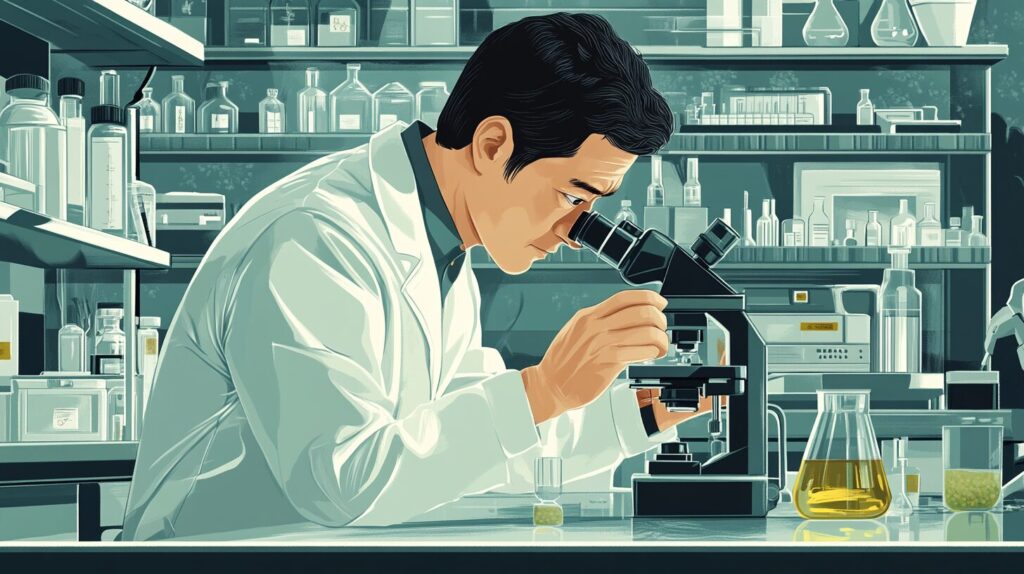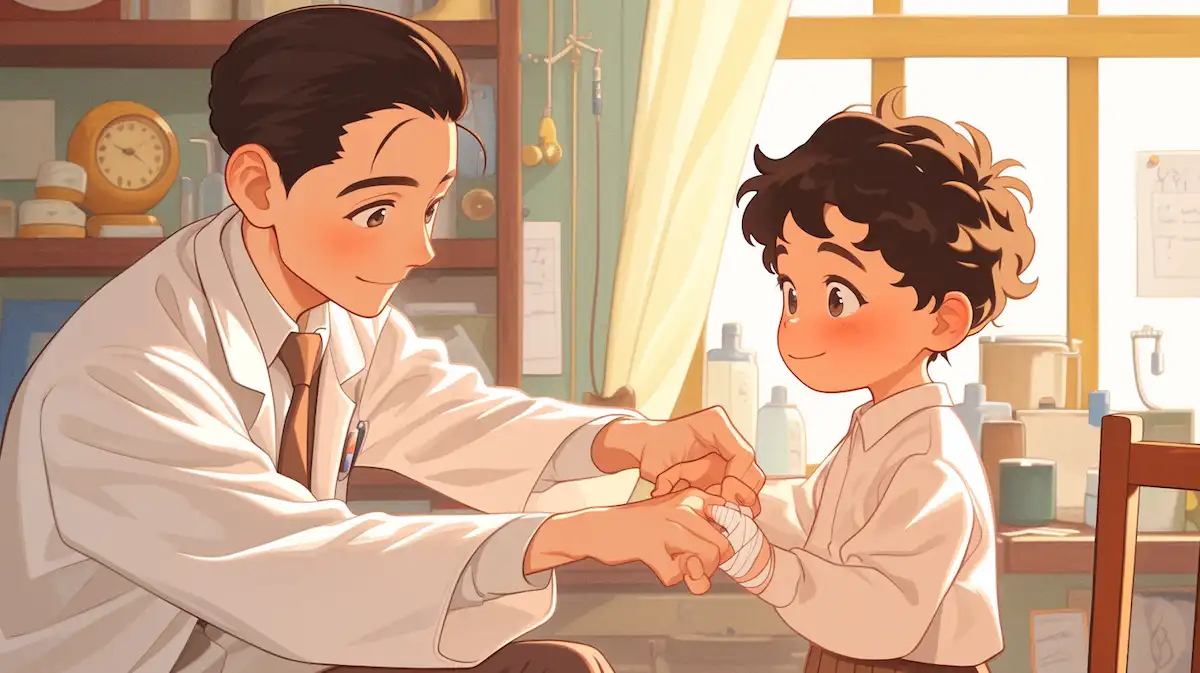野口英世を英語で説明・紹介するための基本情報と、英会話に役立つ表現をシンプルでわかりやすい英語で紹介します。
英会話ダイアローグ・関連情報・10の質問を通して、野口英世に関する英語表現を学びます。
英語
英会話ダイアローグを読む前に知っておくと良い前提知識と情報です。
- 野口英世の生い立ち
- 1歳のときに左手に大きな火傷を負い、手が不自由になった
- しかし、治療を受けた医師に感動し、医師を目指すきっかけとなった
- 科学的背景
- 梅毒は当時、世界的に深刻な感染症問題だった
- 黄熱病は特に熱帯地域で猛威を振るい、多くの命を奪っていた
- アメリカでの活躍
- 貧しい環境からアメリカに渡って研究を続けた
- アメリカでの研究中に、梅毒の原因菌を発見
- 人類への貢献と黄熱病研究
- アフリカ・ガーナに渡り、黄熱病の研究を行った
- 自らも黄熱病に感染し、ガーナで亡くなった
2人が野口英世について話しています。
幼少期の火傷、アメリカでの研究生活、梅毒や黄熱病の研究など、野口英世の生涯と功績などを話題にしています。
会話 / dialogue

Key, I’ve been reading about Hideyo Noguchi lately. He sounds like a fascinating person. Do you know much about him?

Yes, he’s quite well-known in Japan. Noguchi was a bacteriologist, and his work in infectious disease research is famous worldwide. What got you interested in him?

I saw his name and face on an old 1,000-yen bill and got curious. I read that he overcame a lot of challenges, like a severe burn on his hand as a child. That must have been tough.

Definitely. His left hand was partly disabled because of that burn. But instead of giving up, he was inspired by the doctor who treated him and decided to become a doctor himself. That’s where his journey in medicine started.

Wow, that’s amazing! He must have had incredible determination. I also read he went to the United States to pursue his studies. That sounds challenging for someone from Japan back then.

Yes, especially since he had little money and no family there. He had to work various jobs to support himself at first. But he kept going and eventually became known for his research on infectious diseases like syphilis and yellow fever.

Syphilis? I read he discovered the bacteria that causes it. Was that his biggest contribution?

It was one of his major contributions, for sure. His discovery of the syphilis bacterium brought him international fame. People all over respected his work, and he even got nominated for the Nobel Prize multiple times.

That’s impressive! But what about yellow fever? I heard he was studying it in Africa.

Yes, he traveled to Ghana in 1928 to study yellow fever, which was a dangerous disease at the time. Sadly, while he was researching, he caught yellow fever himself and passed away there.

It sounds like he really put his life on the line for his research. That dedication is inspiring.

Absolutely. His commitment to helping humanity was incredible. He went to dangerous areas because he believed his work could make a difference. That’s why he’s so respected even today.

I can see why. And the fact that he was once on the 1,000-yen bill shows how much he’s honored here in Japan.

Right. From 2004 to 2019, his portrait was on the 1,000-yen bill. It was a tribute to his contributions to medicine and to Japan.

I’d love to learn more about his time in the United States. Going abroad back then must have been so different from today.

Very true. Noguchi’s journey wasn’t easy. He started with very little, but through hard work and his talent in research, he gained the respect of the scientific community there.

And he was representing Japan on an international stage. That must have been a proud moment for Japan, especially back then.

Exactly. He helped establish Japan’s reputation in the field of science. Noguchi became a bridge between Japan and the world, which was rare at the time.

He sounds like someone who never gave up, no matter how hard things got. That’s probably why his story is still so powerful.

Yes, his life story is inspiring for so many. He showed that even with challenges, you can achieve something great if you stay dedicated.

I feel like I’ve learned so much about him already. It’s interesting how his life still influences people today.

Definitely. His passion and dedication are lessons for everyone. If you ever get a chance, visiting the Noguchi Hideyo Memorial Museum in his hometown could be really interesting.

That sounds like a great idea! I’d love to see more about his life and work up close. Thanks, Key. This has been really inspiring!
関連情報 / related information
「野口英世」について、理解を深めるための「英語での関連情報」です。
野口英世

Early Life and Inspiration
Hideyo Noguchi was born in 1876 in Japan. When he was a child, he suffered a serious burn on his left hand, which left it partly disabled. Instead of giving up, he was inspired by the doctor who treated him and decided to become a doctor himself. This experience became the starting point of his medical journey.
Achievements in the United States
Noguchi moved to the United States with very little money and no family support. He worked hard and eventually gained recognition for his research on infectious diseases. His most famous discovery was identifying the bacteria that causes syphilis. This work made him well-known worldwide, and he was nominated for the Nobel Prize several times.
Dedication to Humanity
Noguchi traveled to dangerous areas to continue his research. In 1928, he went to Ghana, Africa, to study yellow fever. Sadly, while working there, he caught yellow fever himself and passed away. His dedication to science and helping others inspired many people.
Lasting Impact in Japan
To honor his contributions, Noguchi’s face was featured on the 1,000-yen bill in Japan from 2004 to 2019. His story is respected in Japan and beyond, reminding people of the importance of determination, passion, and dedication.
10の質問 / 10 questions
「野口英世」について、理解を深めるための「英語での10の質問」です。
1: Who was Hideyo Noguchi?
Hideyo Noguchi was a famous Japanese bacteriologist known for his research on infectious diseases like syphilis and yellow fever.
2: What inspired Hideyo Noguchi to become a doctor?
When he was a child, he suffered a severe burn on his hand. He was inspired by the doctor who treated him and decided to pursue a career in medicine.
3: What did Hideyo Noguchi discover about syphilis?
Noguchi discovered the bacterium that causes syphilis. This discovery made him famous worldwide and helped advance research on infectious diseases.
4: Why did Hideyo Noguchi go to the United States?
Noguchi went to the United States to study medicine and do research. He had limited funds but worked hard and gained respect in the scientific community.
5: What was Hideyo Noguchi’s biggest challenge in the United States?
His biggest challenge was starting with very little money and no family support. He had to work different jobs while focusing on his studies and research.
6: Why did Hideyo Noguchi travel to Africa?
Noguchi traveled to Africa, specifically Ghana, to study yellow fever. He was dedicated to understanding and finding treatments for infectious diseases.
7: What happened to Hideyo Noguchi in Ghana?
While studying yellow fever in Ghana, Noguchi unfortunately caught the disease himself and passed away in 1928.
8: Was Hideyo Noguchi recognized internationally?
Yes, Noguchi was well-respected worldwide. He was even nominated for the Nobel Prize several times for his work on infectious diseases.
9: Why was Hideyo Noguchi’s face on the 1,000-yen bill?
His face was on the 1,000-yen bill in Japan from 2004 to 2019 as a tribute to his contributions to medical science and Japan’s reputation internationally.
10: What lesson can we learn from Hideyo Noguchi’s life?
Noguchi’s life teaches us the importance of dedication and perseverance. Despite challenges, he continued his work to help others and made a lasting impact on science.

和訳付
会話 / dialogue

Key, I’ve been reading about Hideyo Noguchi lately. He sounds like a fascinating person. Do you know much about him?
キー、最近野口英世について読んでたんだけど、すごく興味深い人だね。彼についてどれくらい知ってる?

Yes, he’s quite well-known in Japan. Noguchi was a bacteriologist, and his work in infectious disease research is famous worldwide. What got you interested in him?
うん、彼は日本でとても有名だよ。野口は細菌学者で、感染症研究で世界的に知られているんだ。どうして彼に興味を持ったの?

I saw his name and face on an old 1,000-yen bill and got curious. I read that he overcame a lot of challenges, like a severe burn on his hand as a child. That must have been tough.
昔の千円札に彼の名前と顔が載っているのを見て、興味がわいたんだ。それで、子どもの頃にひどい火傷を負ったけど、それを乗り越えたって読んだよ。大変だっただろうね。

Definitely. His left hand was partly disabled because of that burn. But instead of giving up, he was inspired by the doctor who treated him and decided to become a doctor himself. That’s where his journey in medicine started.
そうだね。火傷で左手が不自由になったんだ。でも諦めずに治療してくれた医師に感動して、自分も医者になることを決意したんだ。そこで彼の医学の道が始まったんだよ。

Wow, that’s amazing! He must have had incredible determination. I also read he went to the United States to pursue his studies. That sounds challenging for someone from Japan back then.
すごいね!とてつもない意志の強さだね。それに、アメリカに勉強しに行ったとも読んだよ。あの時代の日本人にとっては大変だったろうね。

Yes, especially since he had little money and no family there. He had to work various jobs to support himself at first. But he kept going and eventually became known for his research on infectious diseases like syphilis and yellow fever.
そう、特にお金がほとんどなく、家族もいなかったからね。最初は生活費を稼ぐために色々な仕事をしていたんだ。でも続けて、最終的には梅毒や黄熱病などの感染症の研究で有名になったんだよ。

Syphilis? I read he discovered the bacteria that causes it. Was that his biggest contribution?
梅毒?彼がその原因菌を発見したって読んだよ。それが彼の最大の功績なの?

It was one of his major contributions, for sure. His discovery of the syphilis bacterium brought him international fame. People all over respected his work, and he even got nominated for the Nobel Prize multiple times.
それは確かに彼の大きな貢献の一つだね。梅毒の原因菌の発見で彼は国際的に有名になったんだ。世界中の人々が彼の仕事を尊敬していて、何度もノーベル賞にノミネートされたんだよ。

That’s impressive! But what about yellow fever? I heard he was studying it in Africa.
すごいね!でも、黄熱病についてはどうなの?アフリカで研究してたって聞いたよ。

Yes, he traveled to Ghana in 1928 to study yellow fever, which was a dangerous disease at the time. Sadly, while he was researching, he caught yellow fever himself and passed away there.
うん、1928年に黄熱病の研究をするためにガーナに行ったんだ。当時、黄熱病はとても危険な病気だったんだ。でも、残念ながら研究中に自分も黄熱病に感染して亡くなってしまったんだ。

It sounds like he really put his life on the line for his research. That dedication is inspiring.
本当に命をかけて研究してたんだね。その献身的な姿勢は感動的だよ。

Absolutely. His commitment to helping humanity was incredible. He went to dangerous areas because he believed his work could make a difference. That’s why he’s so respected even today.
まったくだね。彼の人類への献身は本当にすごいよ。自分の研究が役立つと信じて、危険な場所にも行ったんだ。だからこそ今でも尊敬されているんだよ。

I can see why. And the fact that he was once on the 1,000-yen bill shows how much he’s honored here in Japan.
なるほどね。それに、彼がかつて千円札に載っていたことは、日本でどれだけ彼が敬意を払われているかを表しているね。

Right. From 2004 to 2019, his portrait was on the 1,000-yen bill. It was a tribute to his contributions to medicine and to Japan.
その通り。2004年から2019年まで彼の肖像が千円札に使われていたんだ。彼の医学や日本への貢献に対する賛辞だったんだよ。

I’d love to learn more about his time in the United States. Going abroad back then must have been so different from today.
彼のアメリカでの時代についてもっと知りたいな。当時は今とは違って海外に行くのも大変だったろうね。

Very true. Noguchi’s journey wasn’t easy. He started with very little, but through hard work and his talent in research, he gained the respect of the scientific community there.
本当にその通りだよ。野口の道のりは決して楽じゃなかった。少ない資金で始めたけど、彼の努力と研究の才能のおかげで、科学界で尊敬を得ることができたんだ。

And he was representing Japan on an international stage. That must have been a proud moment for Japan, especially back then.
しかも彼は日本を国際的な舞台で代表していたんだよね。当時の日本にとっては誇りだっただろうね。

Exactly. He helped establish Japan’s reputation in the field of science. Noguchi became a bridge between Japan and the world, which was rare at the time.
その通り。彼は科学の分野で日本の評判を確立するのに貢献したんだ。野口は日本と世界の架け橋になり、当時としては珍しいことだったんだよ。

He sounds like someone who never gave up, no matter how hard things got. That’s probably why his story is still so powerful.
どんなに大変でも諦めない人だったんだろうね。だからこそ、今でも彼の物語は力強いんだと思うよ。

Yes, his life story is inspiring for so many. He showed that even with challenges, you can achieve something great if you stay dedicated.
そうだね。彼の人生は多くの人にとって感動的だよ。困難があっても、情熱を持ち続ければ素晴らしい成果が得られることを示しているんだ。

I feel like I’ve learned so much about him already. It’s interesting how his life still influences people today.
すでに彼についてたくさん学んだ気がするよ。今でも彼の人生が人々に影響を与えているのが面白いね。

Definitely. His passion and dedication are lessons for everyone. If you ever get a chance, visiting the Noguchi Hideyo Memorial Museum in his hometown could be really interesting.
その通りだね。彼の情熱と献身はみんなの学びになるよ。もし機会があれば、彼の故郷にある野口英世記念館を訪れてみると面白いかも。

That sounds like a great idea! I’d love to see more about his life and work up close. Thanks, Key. This has been really inspiring!
それはいいアイデアだね!彼の人生や業績をもっと間近で見てみたいよ。ありがとう、キー。本当に感動したよ!
関連情報 / related information
野口英世

Early Life and Inspiration
Hideyo Noguchi was born in 1876 in Japan. When he was a child, he suffered a serious burn on his left hand, which left it partly disabled. Instead of giving up, he was inspired by the doctor who treated him and decided to become a doctor himself. This experience became the starting point of his medical journey.
野口英世は1876年に日本で生まれました。幼少期に左手に大きな火傷を負い、不自由になってしまいました。しかし、諦めることなく治療してくれた医師に感動し、自分も医師になることを決意しました。この経験が彼の医学の道の始まりとなりました。
Achievements in the United States
Noguchi moved to the United States with very little money and no family support. He worked hard and eventually gained recognition for his research on infectious diseases. His most famous discovery was identifying the bacteria that causes syphilis. This work made him well-known worldwide, and he was nominated for the Nobel Prize several times.
野口はわずかな資金でアメリカに渡り、家族の支援もありませんでした。彼は努力を重ね、感染症研究で認められるようになりました。最も有名な功績は、梅毒の原因菌を発見したことです。この研究で彼は世界的に知られるようになり、何度もノーベル賞にノミネートされました。
Dedication to Humanity
Noguchi traveled to dangerous areas to continue his research. In 1928, he went to Ghana, Africa, to study yellow fever. Sadly, while working there, he caught yellow fever himself and passed away. His dedication to science and helping others inspired many people.
野口は研究を続けるため、危険な地域にも足を運びました。1928年には、黄熱病の研究のためにアフリカのガーナへ向かいましたが、残念ながら自分も黄熱病に感染し、亡くなってしまいました。科学と人類への献身は、多くの人々に感銘を与えました。
Lasting Impact in Japan
To honor his contributions, Noguchi’s face was featured on the 1,000-yen bill in Japan from 2004 to 2019. His story is respected in Japan and beyond, reminding people of the importance of determination, passion, and dedication.
彼の功績を称えるため、2004年から2019年まで日本の千円札に野口英世の肖像が使用されました。彼の物語は日本や世界で尊敬されており、強い意志と情熱、そして献身の大切さを人々に伝えています。
10の質問 / 10 questions
1: Who was Hideyo Noguchi?
野口英世とは誰ですか?
Hideyo Noguchi was a famous Japanese bacteriologist known for his research on infectious diseases like syphilis and yellow fever.
野口英世は、梅毒や黄熱病などの感染症研究で知られる日本の有名な細菌学者です。
2: What inspired Hideyo Noguchi to become a doctor?
野口英世が医者を目指したきっかけは何ですか?
When he was a child, he suffered a severe burn on his hand. He was inspired by the doctor who treated him and decided to pursue a career in medicine.
子供の頃、彼は手に重度の火傷を負いました。治療してくれた医師に感動し、医学の道を目指すことを決意しました。
3: What did Hideyo Noguchi discover about syphilis?
野口英世は梅毒について何を発見しましたか?
Noguchi discovered the bacterium that causes syphilis. This discovery made him famous worldwide and helped advance research on infectious diseases.
野口は梅毒の原因菌を発見しました。この発見は彼を世界的に有名にし、感染症研究の進展に貢献しました。
4: Why did Hideyo Noguchi go to the United States?
なぜ野口英世はアメリカに行ったのですか?
Noguchi went to the United States to study medicine and do research. He had limited funds but worked hard and gained respect in the scientific community.
野口は医学を学び研究するためにアメリカに行きました。資金は限られていましたが、努力を重ねて科学界で尊敬を得ました。
5: What was Hideyo Noguchi’s biggest challenge in the United States?
アメリカでの野口英世の最大の課題は何でしたか?
His biggest challenge was starting with very little money and no family support. He had to work different jobs while focusing on his studies and research.
彼の最大の課題は、ほとんど資金もなく家族の支援もない状態で始めることでした。学業と研究に集中しながら、様々な仕事をして生活費を稼ぐ必要がありました。
6: Why did Hideyo Noguchi travel to Africa?
なぜ野口英世はアフリカに渡ったのですか?
Noguchi traveled to Africa, specifically Ghana, to study yellow fever. He was dedicated to understanding and finding treatments for infectious diseases.
野口は黄熱病を研究するためにアフリカ、特にガーナに渡りました。感染症の理解と治療法の発見に専念していました。
7: What happened to Hideyo Noguchi in Ghana?
ガーナで野口英世に何が起こりましたか?
While studying yellow fever in Ghana, Noguchi unfortunately caught the disease himself and passed away in 1928.
ガーナで黄熱病を研究している最中、残念ながら野口自身も黄熱病に感染し、1928年に亡くなりました。
8: Was Hideyo Noguchi recognized internationally?
野口英世は国際的に認められていましたか?
Yes, Noguchi was well-respected worldwide. He was even nominated for the Nobel Prize several times for his work on infectious diseases.
はい、野口は世界的に尊敬されていました。感染症研究で何度もノーベル賞にノミネートされました。
9: Why was Hideyo Noguchi’s face on the 1,000-yen bill?
なぜ野口英世の顔が千円札に使われたのですか?
His face was on the 1,000-yen bill in Japan from 2004 to 2019 as a tribute to his contributions to medical science and Japan’s reputation internationally.
彼の顔は2004年から2019年まで日本の千円札に使用されました。これは彼の医科学への貢献と国際的な評価への敬意を表したものです。
10: What lesson can we learn from Hideyo Noguchi’s life?
野口英世の人生からどんな教訓が得られますか?
Noguchi’s life teaches us the importance of dedication and perseverance. Despite challenges, he continued his work to help others and made a lasting impact on science.
野口の人生は、献身と忍耐の重要性を教えてくれます。困難があっても他者のために研究を続け、科学に永続的な影響を与えました。

words & phrases
英会話ダイアローグと関連情報に出てきた単語・フレーズです(例文は各3つ)。

bacteriologist : 名詞
意味: 細菌学者。Bacteria(細菌)を研究する科学者。A scientist who studies bacteria and their effects on humans, animals, and plants.
(野口英世が感染症の分野で活躍した細菌学者であったことを示す)
例文:
- She became a bacteriologist to help find treatments for bacterial infections.
「彼女は細菌感染症の治療法を見つけるために細菌学者になりました。」 - The bacteriologist examined samples under the microscope.
「細菌学者は顕微鏡でサンプルを調べました。」 - Many bacteriologists work to understand how bacteria cause diseases.
「多くの細菌学者が、細菌がどのように病気を引き起こすかを理解するために研究しています。」
infectious : 形容詞
意味: 感染性の、伝染性の。Disease that can be passed from one person or organism to another.
(野口英世が研究対象とした梅毒や黄熱病が感染症であることを示す)
例文:
- Coughing and sneezing can spread infectious diseases.
「咳やくしゃみで感染症が広がることがあります。」 - Malaria is a highly infectious disease in certain areas.
「マラリアは特定の地域で非常に感染性の高い病気です。」 - Doctors work hard to control infectious outbreaks in communities.
「医師は地域での感染症の発生を抑えるために努力しています。」
burn : 名詞・動詞
意味: やけど、または火傷を負う。Injury to the skin caused by heat, electricity, or chemicals.
(野口英世が幼少期に手に大きな火傷を負ったことを示す)
例文:
- He suffered a severe burn on his hand.
「彼は手に重度の火傷を負いました。」 - Doctors treated her burn after the accident.
「医師が事故後に彼女の火傷を治療しました。」 - Cooking without gloves can lead to a burn.
「手袋を使わずに料理をすると火傷することがあります。」
disabled : 形容詞
意味: 障害のある、機能が制限されている。Having a physical or mental condition that limits movements, senses, or activities.
(野口英世が火傷により部分的に手が不自由になったことを示す)
例文:
- The disabled athlete competed in the marathon.
「障害のあるアスリートがマラソンに出場しました。」 - Many buildings have ramps for disabled access.
「多くの建物には障害者用のスロープがあります。」 - He designed programs to help disabled children learn.
「彼は障害のある子供たちが学べるプログラムを設計しました。」
tribute : 名詞
意味: 賛辞、敬意を表すもの。An act, statement, or gift meant to show respect, admiration, or gratitude.
(野口英世の功績を称えて彼の肖像が千円札に使用されたことを示す)
例文:
- The statue was built as a tribute to the hero.
「その像は英雄への賛辞として建てられました。」 - She paid tribute to her teacher at the ceremony.
「彼女は式典で先生に敬意を表しました。」 - The award is a tribute to his years of hard work.
「その賞は彼の長年の努力への賛辞です。」
